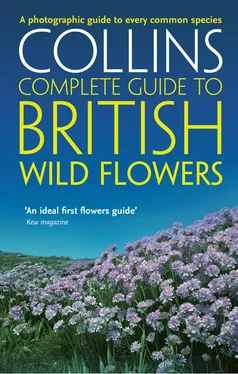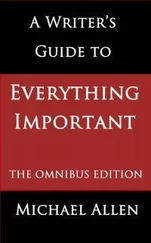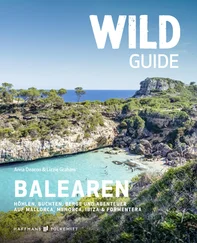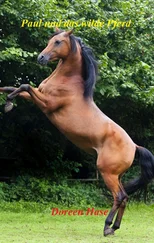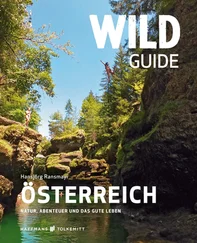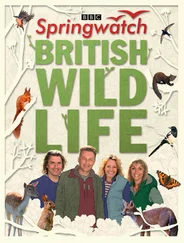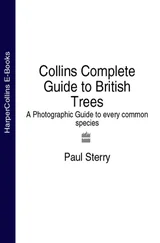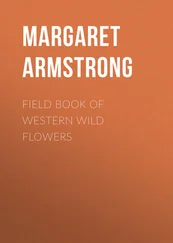In the hope and expectation that readers’ appetites for botanical discoveries are whetted by the book, the last section of Complete British Wild Flowers is devoted to botanical hotspots, areas that merit a visit in search of the localised floral treasures they harbour.
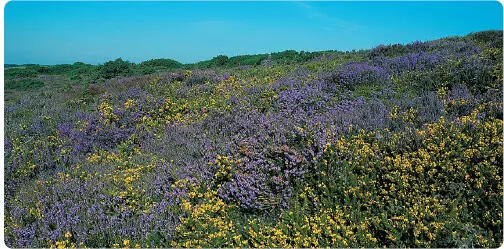
Floral delights such as this heathland have inspired generations of botanists.
THE BOOK HAS BEEN designed so that the text and photographs for each species are on facing pages. A system of labelling clearly states the flower’s identity. The text has been written to complement the information conveyed by the photographs. By and large, the order in which the species appear in the main section of the book roughly follows standard botanical classification. However, because parts of the field are in a state of flux, the order may differ slightly from that found in other guides, past, present or future.
At the start of each species description the plant’s most commonly used and current English name is given. This is followed by the scientific name, comprising the genus name first and then by the specific name. In a few instances, where this is pertinent, reference is made, in either the species heading or the main body of the text, to a further subdivision: subspecies. In general, I have followed the nomenclature of Clive Stace’s New Flora of the British Isles ( see p.). However, with orchids I have used the most up-to-date classification system, which differs from that in most currently available floras. The family group to which the plant in question belongs is then given. If a species is anything other than widespread and common, there then follows a measure of its scarcity, indicated by rosette symbols:
 |
Scarce overall, but locally common |
 |
Scarce, local and seldom common |
|
Local and rare |
These scarcity ratings are based on my own observations, so they are subjective and are not intended as an absolute guide to a species’ status. Lastly in the heading, some measure is given of the plant’s size. Size and stature vary according to a number of factors so these values should be treated with a degree of caution.
The text has been written in as concise a manner as possible. Each description begins with a summary of the plant and the habitat that it favours. To avoid potential ambiguities, the following headings break up the rest of each description: FLOWERS; FRUITS; LEAVES; STATUS. These sections describe the colour, shape and size of the various plant parts – features that tend to be more constant, and hence more useful for identification, than the overall size of the plant. Text in italics relates to key features of identification.
The maps provide invaluable information about the distribution and occurrence of each species in the region: the intensity of the colour gives an indication of abundance. In compiling the maps, I have made reference to a number of sources, including An Atlas of the Wild Flowers of Britain and Northern Europe , the New Atlas of the British and Irish Flora ( see p.), various county floras and, of course, my own notes. The maps represent the current ranges of plants in the region in general terms. Please bear in mind that, given the size of the maps, small and isolated populations will not necessarily be featured. Note also that the ranges of many species (particularly those influenced by agriculture) are likely to contract further as the years go by.
Great care has gone into the selection of photographs for this book and in many cases the images have been taken specifically for this project. Preference has been given to photographs that serve both to illustrate key identification features of a species when in flower, and to emphasise its beauty. In many instances, smaller inset photographs illustrate useful identification features that are not shown clearly by the main image.
IN COMMON WITH OTHER living organisms, plants have the abilities to grow, reproduce themselves, respond to stimuli and – to a limited extent compared to most animals – move. What sets them apart from animals in particular, and defines plants as a group, is their ability, in almost all species, to manufacture their own food from inorganic building blocks. Fundamental to this ability is the process called photosynthesis , in which plants use energy from sunlight to convert carbon dioxide from the air and water into glucose. Oxygen is a by-product of this reaction. A pigment called chlorophyll is the agent that extracts from sunlight the energy needed to fuel the reaction; its coloration is what makes plants green.
The plants covered in this book are the most advanced of their kind in evolutionary terms. All have the ability to reproduce sexually and flowers are the means by which this process is achieved. Flower structure is as varied as it is complex, and the fact that whole books, including this one, can be devoted to detailing its diversity is testament to this. Flower structure is dealt with in more detail on page 10.
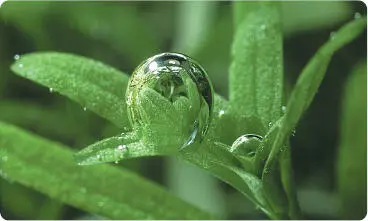
Among terrestrial plants the process of photosynthesis is difficult to demonstrate outside the laboratory. However, certain submerged aquatic plants, such as this Water Starwort, produce bubbles of oxygen when they are exposed to bright sunlight, indicating that photosynthesis is indeed taking place.
THE ROLE OF PLANTS IN ECOLOGY
The importance of plants in the global ecosystem, and at the local level, cannot be overstated. Not only do plants generate (through photosynthesis) the atmospheric oxygen that all animals need to breathe but, as a source of food, they underpin food chains across the world. Without plants, life on earth as we know it would not have evolved and could not survive.
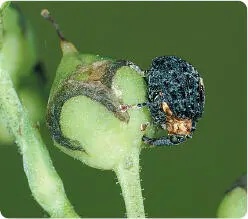
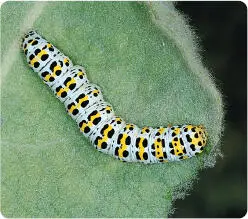
The survival of plants and animals is inextricably linked at the general level, but there are plenty of highly specific instances of dependence, the relationship often hinted at by their English names. Without their namesake-specific foodplants, neither the Figwort Weevil (left) nor the Mullein Moth (right), shown here as a caterpillar, could survive.
Achene– one-seeded dry fruit that does not split.
Acute– sharply pointed.
Alien– introduced by man from another part of the world.
Alternate– not opposite.
Annual– plant that completes its life cycle within 12 months.
Читать дальше
